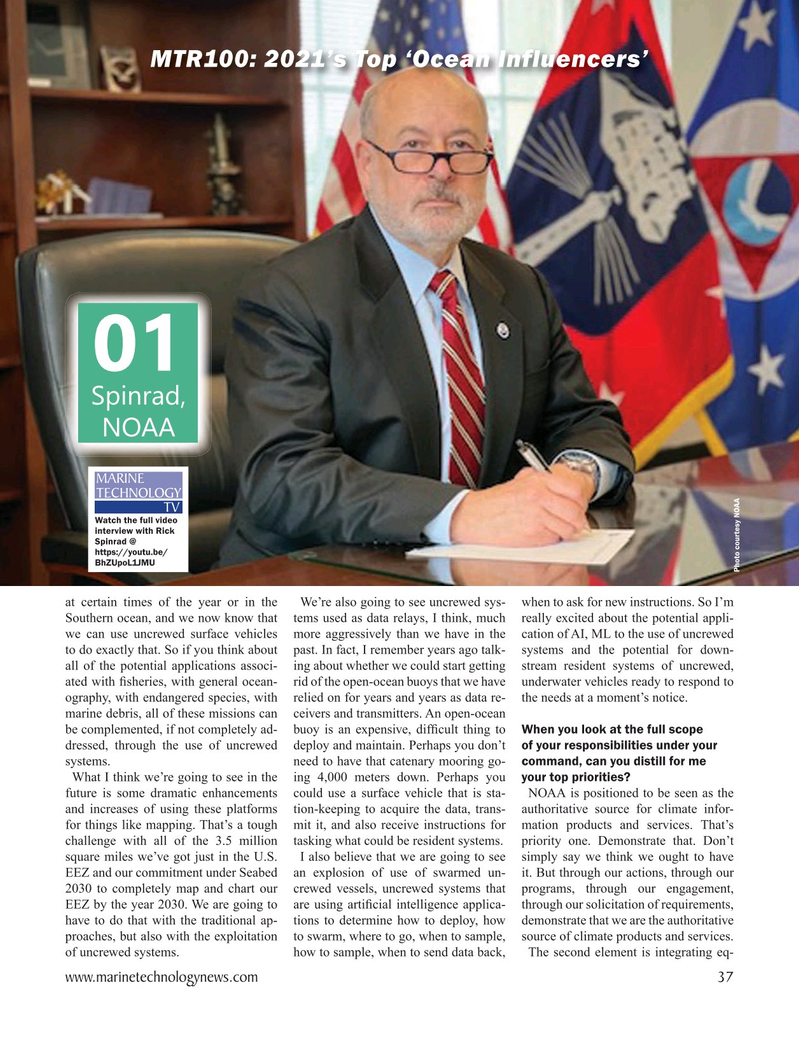
Page 37: of Marine Technology Magazine (September 2021)
MTR100: Focus on 100 Leading Companies, People and Innovations in the Subsea Space
Read this page in Pdf, Flash or Html5 edition of September 2021 Marine Technology Magazine
MTR100: 2021’s Top ‘Ocean Influencers’ 01
Spinrad,
NOAA
MARINE
TECHNOLOGY
TV
Watch the full video interview with Rick
Spinrad @ https://youtu.be/
BhZUpoL1JMU
Photo courtesy NOAA at certain times of the year or in the We’re also going to see uncrewed sys- when to ask for new instructions. So I’m
Southern ocean, and we now know that tems used as data relays, I think, much really excited about the potential appli- we can use uncrewed surface vehicles more aggressively than we have in the cation of AI, ML to the use of uncrewed to do exactly that. So if you think about past. In fact, I remember years ago talk- systems and the potential for down- all of the potential applications associ- ing about whether we could start getting stream resident systems of uncrewed, ated with ? sheries, with general ocean- rid of the open-ocean buoys that we have underwater vehicles ready to respond to ography, with endangered species, with relied on for years and years as data re- the needs at a moment’s notice.
marine debris, all of these missions can ceivers and transmitters. An open-ocean be complemented, if not completely ad- buoy is an expensive, dif? cult thing to When you look at the full scope dressed, through the use of uncrewed deploy and maintain. Perhaps you don’t of your responsibilities under your systems. need to have that catenary mooring go- command, can you distill for me
What I think we’re going to see in the ing 4,000 meters down. Perhaps you your top priorities?
future is some dramatic enhancements could use a surface vehicle that is sta- NOAA is positioned to be seen as the and increases of using these platforms tion-keeping to acquire the data, trans- authoritative source for climate infor- for things like mapping. That’s a tough mit it, and also receive instructions for mation products and services. That’s challenge with all of the 3.5 million tasking what could be resident systems. priority one. Demonstrate that. Don’t square miles we’ve got just in the U.S. I also believe that we are going to see simply say we think we ought to have
EEZ and our commitment under Seabed an explosion of use of swarmed un- it. But through our actions, through our 2030 to completely map and chart our crewed vessels, uncrewed systems that programs, through our engagement,
EEZ by the year 2030. We are going to are using arti? cial intelligence applica- through our solicitation of requirements, have to do that with the traditional ap- tions to determine how to deploy, how demonstrate that we are the authoritative proaches, but also with the exploitation to swarm, where to go, when to sample, source of climate products and services.
of uncrewed systems. how to sample, when to send data back, The second element is integrating eq- www.marinetechnologynews.com 37
MTR #7 (34-49).indd 37 9/22/2021 2:18:01 PM

 36
36

 38
38
